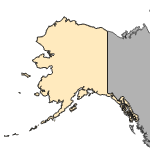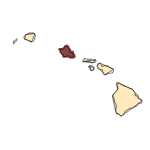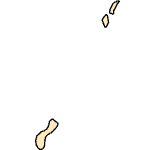Physella acuta
(Acute bladder snail)
Mollusks-Gastropods
Native Transplant |
|
Common name: Acute bladder snail
Synonyms and Other Names: Physa acuta, Physella cubensis, Physella heterostropha, Physella integra, Physella virgata, Physella zionis, European physa, tadpole snail (Dillon et al. 2002; Wethington and Lydeard, 2007; Bousset et al. 2014; Fruh et al., 2017)
Taxonomy: available through
www.itis.gov
Identification: As is characteristic of the genus, Physa has a sinistral (left-opening aperture) shell, extended mantle margin, or edge, that partially covers the shell (Paraense and Pointier 2003, Wethington and Lydeard 2007). Specific to P. acuta is a thin shell with spire elongate, but short, with five whorls. The shell is a light “fawn” color, with the body being gray and covered in fleck spots on the top mantle under the shell; this flecking on the mantle is often visible through the thin shell (C. Morningstar, pers. obs.). The aperture, or shell opening, is ear-shaped, and the suture slightly impressed (Paraense and Pointier 2003).
Size: Up to 16mm in height and 9mm in width (Paraense and Pointier 2003)
Native Range: As the common name “European physa” suggests, Physa acuta was once thought to be native to Europe and introduced to North America (Dillon et al. 2002, Ebbs et al. 2018). However, recent genetic analyses showed that P. acuta is closely related to North American physid snails. Furthermore, the presence of abundant fossil records in North America and absence of fossils in Europe suggest that P. acuta is native to North America and has been introduced to Europe (Dillon et al. 2002, Lydeard, et. al. 2016, Ebbs et al. 2018).
The species’ native range within the United States is currently under question, as the species is spread throughout much of the U.S. and may be a native transplant in some areas. A study by Ebbs et al. (2018) suggests that this species is native to the eastern United States populations, and that populations in the western U.S. are the result of re-introductions from outside of the U.S. (originally introduced and spread from U.S.). The original introduction of P. acuta outside of the U.S. is also thought to be from the eastern United States (Anderson et al. 2018).



|

Alaska |

Hawaii |

Puerto Rico &
Virgin Islands |

Guam Saipan |
Hydrologic Unit Codes (HUCs) Explained
Interactive maps: Point Distribution Maps
Nonindigenous Occurrences:
Uncertain. In the United States, evidence supports an eastern native range, and it is possible that the western populations of this species are the result of an introduction from outside of the United States and subsequent introductions from the east (Anderson 2003, Ebbs et al. 2018, Boussett et al. 2018,); however, genetic evidence can also be interpreted to support the existence of native populations in the western United States prior to the exotic introductions (Ebbs et al. 2018), making the native status of this species troublesome. While the boundary of its native range in the United States is yet to be determined, the source population of the European introduction is likely from the Mississippi River Drainage (Anderson 2003). Conservatively using the Mississippi River basin as the eastern edge of the native range, populations in the Snake River of Idaho, Barton Springs of Austin, Texas, streams in Colorado and New Mexico west of the Rocky Mountains, and streams in Arizona and California are likely introduced; future studies are needed to delineate the native range.
Physa acuta is spread throughout the world, occurring on all continents, except for Antarctica (Bousset et al. 2014). The invasion history of P. acuta outside of North America was examined by Ebbs et al. (2018). The species is thought to have first been introduced into France from the United States via the cotton trade in the early 1800’s where it was first described (Dillon et al. 2002, Anderson 2003; Ebbs et al. 2018). After its introduction in France, the species was recorded in England in the mid 1800’s by Jefferys (1862), where it was thought to have been introduced from the Caribbean via tropical plants. Jefferys noted that the individuals found in England and those found in France were indistinguishable. The species’ introduction to Western Europe, and much of the world, is due to multiple, independent introductions, based on the genetic analyses by Ebbs et al (2018); prior to this study, it was hypothesized that the global invasion of the species was sourced from Western European colonization (Ebbs et al. 2018).
The ubiquity of P. acuta is thoroughly summarized by Paraense and Pointier (2003).
Table 1. States with nonindigenous occurrences, the earliest and latest observations in each state, and the tally and names of HUCs with observations†. Names and dates are hyperlinked to their relevant specimen records. The list of references for all nonindigenous occurrences of Physella acuta are found here.
Table last updated 1/20/2026
† Populations may not be currently present.
Ecology: Physa acuta occupies a wide variety of freshwater habitats, from rivers to lakes and ponds, and habitats that vary widely in water availability, such as ditches (Winterbourn 1973; Bousset et al. 2004). This species has a lung and breathes air (Dillon et al, 2013), and it is often found near the water surface where it can access oxygen (Winterbourn 1973). Physid snails feed on detritus as well as algae (Duncan 1959). Physa acuta is hermaphroditic, meaning that it possesses both male and female reproductive organs, is capable of self-fertilization, and has a high reproductive output (Dillon and Wethington 2004, Wethington and Lydeard 2007, Bousset et al. 2014). Adults lay 50-100 eggs each week for up to a year after becoming sexually mature (Wethington and Dillon 1993).
Means of Introduction: The modern spread of P. acuta is via the aquarium trade, mostly due to the movement of aquatic plants; however, the animal has been distributed around the world through a variety of anthropogenic processes (Jefferys 1862, Winterbourn 1973, Duggan 2010). The original spread of P. acuta outside of North America is attributed to the cotton trade, where animals from Mississippi were brought to France (Dillon et al. 2002, Anderson 2003, Ebbs et al. 2018). Subsequently, this species spread throughout Europe and the Mediterranean (Dillon et al. 2002, Anderson 2003).
Status: Established and widespread globally (Dillon et al. 2002; Duggan 2010; Bousset et al. 2014; Dillon et al. 2018). This species is currently stable in the native range of the United States. The boundary of the native range within the United States is uncertain (Ebbs et al. 2018).
Impact of Introduction: Physa acuta has been documented to dominate and displace native snail fauna in some areas where it is introduced (Dobson 2004; Ebbs et al. 2018). Physa acuta has been shown to be a host for the trematodes that cause ‘swimmers itch’ in humans, and infected P. acuta have been found in the United States (Brant and Loker 2009).
The introduction of P. acuta in Mozambique has indirectly resulted in the reduction of human parasitic infection by trematodes that cause Schistosomiasis; P. acuta displaced most of the native snail fauna in the area, eliminating the secondary hosts for these human pathogens (Dobson 2004).
A study of competitive interactions between a native European physid snail, Physa fontinalis, and the introduced Physa acuta showed that in habitats with higher temperatures, P. acuta growth rate was stimulated, giving the alien species a competitive advantage over the native species (Fruh et al. 2017).
References: (click for full references)
Anderson, R. 2003.
Physella (Costatella) acuta Draparnaud in Britain and Ireland-its taxonomy, origins and relationships to other introduced Physidae. Journal of Conchology 38:7-21.
Bousset, L., J.-P. Pointier, P. David, P. Jarne. 2014. Neither variation loss, nor change in selfing rate is associated with the worldwide invasion of Physa acuta from its native North America. Biological Invasions 16:1769-1783.
Brant, S.V., and E.S. Loker. 2009. Schistosomes in the southwest United States and their potential for causing cercarial dermatitis or "swimmer's itch". Journal of Helminthology 83(2):191-198. https://www.ncbi.nlm.nih.gov/pmc/articles/PMC2892308/pdf/nihms205449.pdf.
Dobson, M. 2004. Replacement of the native freshwater snail by the exotic Physa acuta (Gastropoda: Physidae) in southern Mozambique; a possible control mechanism for schistosomiasis. Annals of Tropical Medicine & Parasitology 98(5):543-548.
Duggan, I.C. 2010. The freshwater aquarium trade as a vector for incidental invertebrate fauna. Biological Invasions 12:3757-3770.
Duncan, C.J. 1959. The Life Cycle and Ecology of the Freshwater Snail Physa fontinalis (L.). Journal of Animal Ecology 28(1):97-117.
Dillon, R. T., Jr., and colleagues. 2018. Physa acuta. The freshwater gastropods of North America. http://www.fwgna.org/. Accessed on 02/04/2019.
Dillon, R.T., A.R. Wethington, J.M. Rhett, and T.P. Smith. 2002. Populations of the European freshwater pulmonate Physa acuta are not reproductively isolated from American Physa heterostropha or Physa integra. Invertebrate Biology 121(3):226-234.
Dillon RT Jr, Wethington AR. 2004. No-choice mating experiments among six nominal taxa of the subgenus Physella (Basommatophora: Physidae). Heldia. 6: 69–78.
Ebbs, E.T., E.S. Loker, and S.V. Brant. 2018. Phylogeography and genetics of the globally invasive snail Physa acuta Draparnaud 1805, and its potential to serve as an intermediate host to larval digenetic trematodes. BMC Evolutionary Biology 18(103):1-17.
Fruh, D., P. Haase, and S. Stoll. 2017. Temperature drives asymmetric competition between alien and indigenous freshwater snail species, Physa acuta and Physa fontinalis. Aquatic Sciences 79:187-195.
Jefferys, J.G. 1862. British Conchology, Or an Account of the Mollusca which Now Inhabit the British Isles and the Surrounding Seas: Land and Freshwater Shells. Volume 1. J. Van Voorst. https://www.biodiversitylibrary.org/item/55187#page/222/mode/1up.
Lydeard, C., D. Campbell, M. Golz. 2016. Physa Acuta Draparnaud, 1805, should be treated as a native of North American, not Europe. Malacologia 59(2):347-350.
Paraense, W.L., and J-P. Pointier. 2003. Physa acuta Draparnaud, 1805 (Gastropoda: Physidae): a study of topotypic specimens. Mem. Inst. Oswaldo Cruz (in Rio de janeiro) 98(4):513-517.
Vinarski, M.V. 2017. The history of an invasion: phases of the explosive spread of the physid snail Physella acuta through Europe, Transcaucasia and Central Asia. Biological Invasions 19:1299-1314. https://link.springer.com/content/pdf/10.1007%2Fs10530-016-1339-3.pdf.
Wethington, A.R., and R.T. Dillon. 1993. Reproductive development in the hermaphroditic freshwater snail Physa monitored with complementing albino lines. Proceedings of the Royal Society of London, Series B, Biological Sciences 252:109-114.
Wethington, A.R., and C. Lydeard. 2007. A molecular phylogeny of Physidae (Gastropoda: Basommatophora) based on mitochondrial DNA sequences. Journal of Molluscan Studies 73(3):241-257. http://www.fwgna.org/downloads/wethingtonlydeard.pdf.
Winterbourn, M.J. 1973. A guide to the freshwater Mollusca of New Zealand. Tuatara 20(3):141-159.
Other Resources:
http://www.fwgna.org
Global Invasive Species Database Profile
Author:
Morningstar, C.R., and Daniel, W.M.
Revision Date: 3/5/2021
Peer Review Date: 5/21/2019
Citation Information:
Morningstar, C.R., and Daniel, W.M., 2026, Physella acuta (Draparnaud,1805): U.S. Geological Survey, Nonindigenous Aquatic Species Database, Gainesville, FL, https://nas.er.usgs.gov/queries/factsheet.aspx?SpeciesID=1025, Revision Date: 3/5/2021, Peer Review Date: 5/21/2019, Access Date: 1/20/2026
This information is preliminary or provisional and is subject to revision. It is being provided to meet the need for timely best science. The information has not received final approval by the U.S. Geological Survey (USGS) and is provided on the condition that neither the USGS nor the U.S. Government shall be held liable for any damages resulting from the authorized or unauthorized use of the information.